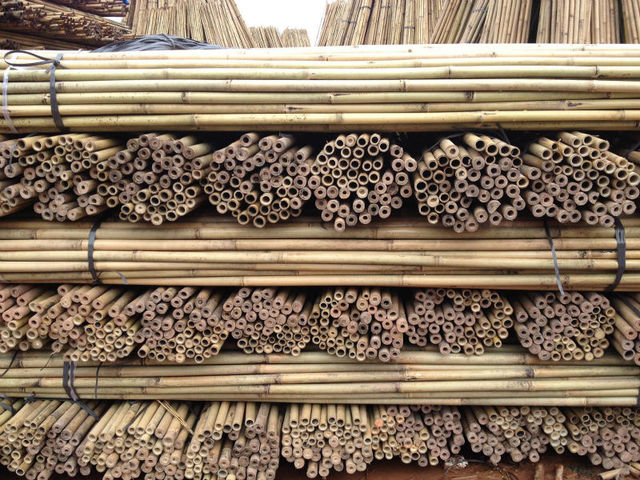Why Bamboo for Garden Stakes is the Best Eco-Friendly Choice
Introduction
Bamboo has long been celebrated as one of nature’s most versatile materials, and its application in gardening is no exception. Among its many uses, bamboo for garden stakes stands out as a sustainable, durable, and attractive choice for gardeners. As concerns about environmental impact grow, bamboo offers an eco-friendly alternative to traditional materials like plastic and metal. This article explores why bamboo garden stakes are the best choice for modern, sustainable gardening practices.

What Are Garden Stakes?
Garden stakes are essential tools for supporting plants as they grow. They help keep plants upright, provide structure for climbing species, and protect fragile stems from breaking. Stakes are particularly useful in vegetable gardening, offering support for tomatoes, beans, and other vining plants. While stakes can be made from various materials, bamboo provides a unique blend of functionality and sustainability.
Why Choose Bamboo for Garden Stakes?
When selecting a material for garden stakes, bamboo ticks all the right boxes. Here’s why:
- Sustainability: Bamboo grows rapidly, with some species maturing in just a few years, making it a highly renewable resource.
- Durability: Despite its lightweight nature, bamboo is incredibly strong and can withstand harsh weather conditions.
- Aesthetics: Its natural appearance blends seamlessly into garden settings, adding a rustic charm.
Advantages of Using Bamboo
Bamboo offers several key benefits that make it ideal for garden stakes:
- Eco-Friendly: Bamboo decomposes naturally without harming the environment.
- Lightweight Yet Strong: It’s easy to handle but sturdy enough to support heavy plants.
- Pest-Resistant: Bamboo’s natural silica content helps repel pests.
- Affordable: It’s cost-effective compared to metal or treated wooden stakes.
Sustainability of Bamboo
Bamboo is a wonder plant when it comes to sustainability. Unlike hardwood trees, which take decades to mature, bamboo can grow up to 3 feet per day under optimal conditions. This rapid growth makes it a renewable resource with minimal environmental impact. Additionally, bamboo forests help reduce carbon dioxide levels, contributing positively to global efforts against climate change.
How to Use Bamboo for Garden Stakes
Using bamboo stakes is simple and versatile. Follow these steps:
- Cut Bamboo to Size: Choose lengths appropriate for the plants you’re supporting.
- Position Stakes: Insert stakes into the soil near the plant base, ensuring they’re stable.
- Secure Plants: Use soft ties or twine to attach plants to the stakes, allowing room for growth.
Popular Gardening Applications
Bamboo garden stakes can be used in various ways, including:
- Tomato Cages: Support growing tomato plants.
- Bean Poles: Create tepees for climbing beans.
- Trellises: Build vertical structures for flowers and vegetables.
Comparing Bamboo to Other Materials
Here’s how bamboo stacks up against other common materials:
| Material | Pros | Cons |
|---|---|---|
| Bamboo | Eco-friendly, strong, aesthetic | Requires maintenance |
| Wood | Readily available, sturdy | Susceptible to rot and pests |
| Metal | Extremely durable, weatherproof | Expensive, heavy |
| Plastic | Lightweight, inexpensive | Not biodegradable, less sturdy |
Types of Bamboo Suitable for Garden Stakes
Certain bamboo species work better as garden stakes. Common choices include:
- Moso Bamboo: Known for its strength and thickness.
- Tonkin Bamboo: Lightweight and flexible, ideal for smaller plants.
How to Prepare Bamboo for Garden Stakes
To maximize durability, bamboo stakes require preparation:
- Harvest Mature Bamboo: Use bamboo that is at least 3 years old.
- Cut to Desired Lengths: Use a saw or sharp tool.
- Treat Bamboo: Soak in a borax solution to prevent rot and pests.
- Dry Thoroughly: Air-dry in a shaded area to prevent cracking.
DIY Bamboo Garden Projects
In addition to stakes, bamboo can be used creatively in the garden:
- Bamboo Fencing: Adds privacy and a natural look.
- Decorative Borders: Create edging for flower beds.
- Hanging Planters: Use hollowed bamboo as unique planters.
Common Challenges and Solutions
While bamboo is durable, it has its challenges:
- Rot: Prevent this by treating and storing bamboo properly.
- Splitting: Use sharp tools and cut carefully.
Where to Buy Bamboo for Garden Stakes
You can find quality bamboo stakes at:
- Online Retailers: Wellco Wholesale, Etsy, or specialty gardening websites.
- Local Nurseries: Check for locally sourced bamboo.
- Wholesale Suppliers: Ideal for large-scale gardening projects.
Tips for Prolonging the Life of Bamboo Stakes
- Clean After Use: Remove soil and debris to prevent rot.
- Store Properly: Keep in a dry, shaded area.
- Re-Treat Annually: Reapply protective treatments as needed.
FAQs About Bamboo for Garden Stakes
-
Is bamboo strong enough for large plants?
Yes, bamboo’s tensile strength makes it suitable for heavy plants like tomatoes. -
Does bamboo rot quickly?
Untreated bamboo can rot, but proper treatment significantly extends its lifespan. -
Can I reuse bamboo stakes?
Absolutely! With proper care, bamboo stakes can last several seasons. -
Is bamboo safe for organic gardening?
Yes, bamboo is a natural, chemical-free option for organic gardens. -
What’s the best way to secure plants to bamboo stakes?
Use soft ties or natural twine to avoid damaging plant stems. -
Can bamboo stakes be painted?
Yes, you can paint them for added weather protection or aesthetic appeal.
Conclusion
Bamboo garden stakes are an exceptional choice for eco-conscious gardeners seeking a balance between functionality and sustainability. Lightweight, durable, and biodegradable, bamboo provides reliable plant support while reducing environmental impact. By incorporating bamboo into your gardening practices, you can cultivate a greener, more sustainable garden.

